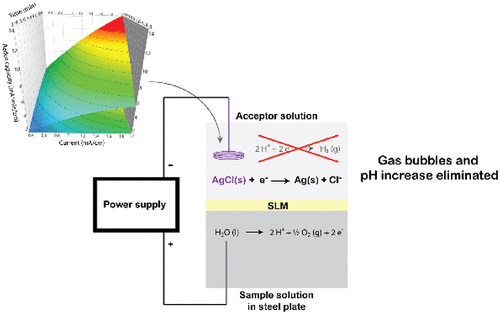当前位置:
X-MOL 学术
›
Anal. Chem.
›
论文详情
Our official English website, www.x-mol.net, welcomes your feedback! (Note: you will need to create a separate account there.)
Electromembrane Extraction Using Sacrificial Electrodes.
Analytical Chemistry ( IF 7.4 ) Pub Date : 2020-03-30 , DOI: 10.1021/acs.analchem.0c00626 Frederik A Hansen 1 , Henrik Jensen 2 , Stig Pedersen-Bjergaard 1, 2
Analytical Chemistry ( IF 7.4 ) Pub Date : 2020-03-30 , DOI: 10.1021/acs.analchem.0c00626 Frederik A Hansen 1 , Henrik Jensen 2 , Stig Pedersen-Bjergaard 1, 2
Affiliation

|
In this paper, we report the first example of employing a sacrificial electrode in the acceptor solution during electromembrane extraction (EME). The electrode was based on a silver wire with a layer of silver chloride electroplated onto the surface. During EME, the electrode effectively inhibited electrolysis of water in the acceptor compartment, by accepting the charge transfer across the SLM, which enabled the application of 500 μA current without suffering gas formation or pH changes from electrolysis of water. The electroplating strategy was optimized with a design-of-experiments (DOE) methodology that provided optimal conditions of electroplating. With an optimized electrode, 1 cm of the electrode in contact with the acceptor solution inhibited electrolysis of water for approximately 30 min at 500 μA current (redox capacity). Further, the redox capacity of the electrode was found to increase through multiple uses. The advantage of the electrode was demonstrated by extracting polar analytes at high-current conditions in a standard EME system comprising 2-nitrophenyl octyl ether (NPOE) as SLM and 10 mM HCl as sample/acceptor solutions. Application of high current enabled significantly higher recoveries than could otherwise be obtained at 100 μA. Sacrificial electrodes were also tested in μ-EME and were found beneficial by eliminating detrimental bubble formation. Thus, the sacrificial electrodes improved the stability of μ-EME systems. The findings of this paper are important for development of stable and robust systems for EME operated at high voltage/current and for EME performed in narrow channels/tubing where bubble formation is critical.
中文翻译:

使用牺牲电极进行电膜萃取。
在本文中,我们报告了在电膜萃取(EME)期间在受体溶液中使用牺牲电极的第一个示例。电极基于银丝,表面上电镀有一层氯化银。在EME期间,电极通过接受跨SLM的电荷转移,有效地抑制了受体隔室中水的电解,这使得能够施加500μA电流而不会因水电解而形成气体或改变pH。通过实验设计(DOE)方法优化了电镀策略,该方法提供了最佳的电镀条件。使用优化的电极,与受体溶液接触的1 cm电极在500μA电流(氧化还原容量)下抑制水电解约30分钟。进一步,发现电极的氧化还原容量通过多次使用而增加。通过在标准的EME系统中以高电流条件萃取极性分析物来证明电极的优势,该系统包含2-硝基苯基辛基醚(NPOE)作为SLM和10 mM HCl作为样品/受体溶液。高电流的应用使回收率大大高于在100μA情况下可获得的回收率。牺牲电极也在μ-EME中进行了测试,发现可以消除有害的气泡形成,因此是有益的。因此,牺牲电极改善了μ-EME系统的稳定性。本文的研究结果对于开发稳定和坚固的EME系统非常重要,该系统用于在高电压/电流下运行的EME,以及在气泡形成至关重要的狭窄通道/管道中执行的EME。
更新日期:2020-03-30
中文翻译:

使用牺牲电极进行电膜萃取。
在本文中,我们报告了在电膜萃取(EME)期间在受体溶液中使用牺牲电极的第一个示例。电极基于银丝,表面上电镀有一层氯化银。在EME期间,电极通过接受跨SLM的电荷转移,有效地抑制了受体隔室中水的电解,这使得能够施加500μA电流而不会因水电解而形成气体或改变pH。通过实验设计(DOE)方法优化了电镀策略,该方法提供了最佳的电镀条件。使用优化的电极,与受体溶液接触的1 cm电极在500μA电流(氧化还原容量)下抑制水电解约30分钟。进一步,发现电极的氧化还原容量通过多次使用而增加。通过在标准的EME系统中以高电流条件萃取极性分析物来证明电极的优势,该系统包含2-硝基苯基辛基醚(NPOE)作为SLM和10 mM HCl作为样品/受体溶液。高电流的应用使回收率大大高于在100μA情况下可获得的回收率。牺牲电极也在μ-EME中进行了测试,发现可以消除有害的气泡形成,因此是有益的。因此,牺牲电极改善了μ-EME系统的稳定性。本文的研究结果对于开发稳定和坚固的EME系统非常重要,该系统用于在高电压/电流下运行的EME,以及在气泡形成至关重要的狭窄通道/管道中执行的EME。



























 京公网安备 11010802027423号
京公网安备 11010802027423号